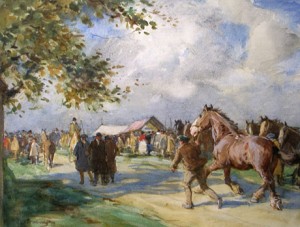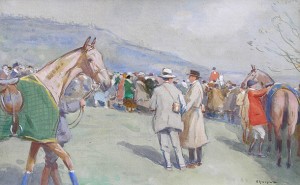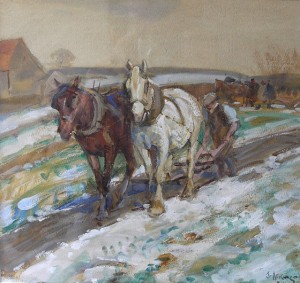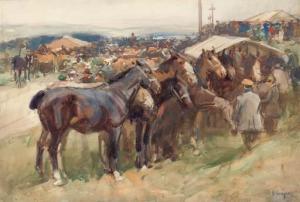Atkinson’s horses for Thursday Art Day
I’m really excited to present several of John Atkinson’s paintings for Thursday art day. There is a remarkable quality to John Atkinson’s artwork and especially his horses.
‘Stagshaw Horse Fair’
Single brush strokes highlight in such a way they appear to bring the horses to life. A wonderful example is the farmer ploughing in ‘Ploughing in Winter’ with some snow on the ground. The movement of the horses is captured perfectly while in ‘The Meet’ the two men discussing the hunt has you dying to know what they’re discussing. My favourite of this small group is ‘Stagshaw Horse Fair’ the horse dealer is showing his horses paces for prospective buyers. The horse’s beside are staring with curiosity as the horse trots by and the serious stance of the three men appear to be watching every stride of the horse. Most horse people have been witness to this type of stance from prospective purchasers! Even with the handler of the trotting horse there’s a feeling of ‘c’mon lad trot up nicely!’ I just love it. John Atkinson has captured the very essence of times gone by. An era never to return.
‘The Meet’
John Atkinson (1863 -1924) was born in Newcastle and had a variety of jobs before studying art at the city’s School of Art. It was probably while working as secretary to the industrialist and art patron, Dr. Charles Mitchell, that he learnt the Pitman’s shorthand which he later used to annotate his sketches. He became recognised as an artist through his many exhibits at the Bewick Club in Newcastle. Between 1900 and 1914 he lived in North Yorkshire, first at Sleights and then at Broadleas, Glaisdale where he worked and exhibited with the Staithes Group. The first of ten pictures by him to be
exhibited at the Royal Academy was sent in from Sleights in 1901. He was elected a member of the Staithes Art Club in 1907. Scenes on the moors above Staithes, often featuring horses, were one of his favourite subjects during this period. Of all this group of artists, he was the one most concerned with depicting rural as opposed to coastal life, although he did paint seaside scenes from time to time. He specialised in anatomically accurate pictures of animals, especially horses, depicted with a fluidity of line which imbues his work with life and movement. His lively pencil sketches show his qualities as a draughtsman. He frequently painted farm labourers and gypsies, visiting Appleby Horse Fair many times and also painting Yarm Fair.
‘Ploughing in Winter’
He was able to capture the characters of the people he painted and the essence of the situations in which he found them, hayfield, gypsy encampment or outside the pub at Egton Bridge. His sketch books show how quickly he was able to do this with few, swift pencil lines. He worked mainly in watercolours, and, generally speaking, works in this medium are of better quality than his oils, although some of the latter are superb. He used broad, strong brushstrokes to recreate horses, cows, poultry and people in settings where light is as important as the landscape. Atkinson was a keen supporter of the RSPCA and provided them with illustrations for their publications.
‘The Appleby Horse Fair Cumbria’
He embraced many aspects of art, teaching at Ushaw College, Durham and the Grammar School in Morpeth; he painted inn signs, particularly for villages in the Thames Valley, and during the First World War he was an artist for the Newcastle Chronicle, possibly the reason for his leaving Glaisdale. His work hangs in public galleries in Gateshead, Middlesbrough, Newcastle, South Shields, Sunderland and Whitby. He exhibited at the Bewick Club, the Walker Gallery, Newcastle, Manchester City Art Gallery, the Royal Academy, the Royal Institute of Painters in Water Colours, the Royal Scottish Academy, the Staithes Art Club and the Yorkshire Union of Artists. His work hangs in public galleries in Gateshead, Middlesbrough, Newcastle, South Shields, Sunderland and Whitby.




One Response
Jenny Gallup-King
Thanks Carmel for sharing both “Horses, Nature and Inner Peace” and also John Atkinson’s paintings (many of which are very familiar to me) and his biography – a great artist indeed.